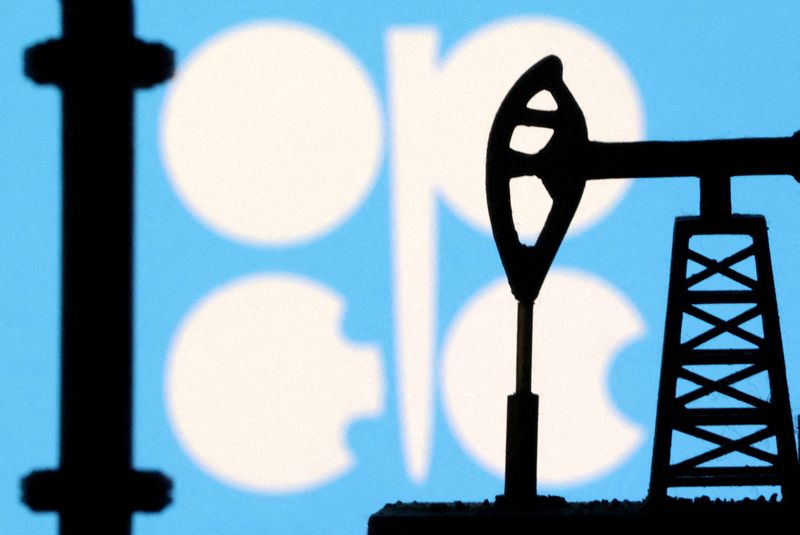
© Reuters. FILE PHOTO: OPEC logo is seen in this illustration taken, October 8, 2023. REUTERS/Dado Ruvic//File Photo
LCO
+0.14%
Add to/Remove from Watchlist
Add to Watchlist
Add Position
Position added successfully to:
Please name your holdings portfolio
Type:
BUY
SELL
Date:
Amount:
Price
Point Value:
Leverage:
1:1
1:10
1:25
1:50
1:100
1:200
1:400
1:500
1:1000
Commission:
Create New Watchlist
Create
Create a new holdings portfolio
Add
Create
+ Add another position
Close
CL
+0.22%
Add to/Remove from Watchlist
Add to Watchlist
Add Position
Position added successfully to:
Please name your holdings portfolio
Type:
BUY
SELL
Date:
Amount:
Price
Point Value:
Leverage:
1:1
1:10
1:25
1:50
1:100
1:200
1:400
1:500
1:1000
Commission:
Create New Watchlist
Create
Create a new holdings portfolio
Add
Create
+ Add another position
Close
SINGAPORE (Reuters) – Oil prices held steady on Tuesday ahead of key interest rate policy and inflation data announcements, and amid doubts that production cuts by OPEC+ next year would offset crude oversupply and weaker fuel demand growth.
Brent crude futures for February were flat at $76.03 a barrel as of 0103 GMT, while U.S. West Texas Intermediate crude futures for January delivery were up 3 cents at $71.35 a barrel.
Both the contracts settled marginally higher on Monday, with Brent up 19 cents at $76.03 a barrel and WTI up 9 cents at $71.32.
The Organization of the Petroleum Exporting Countries and allies, together called OPEC+, have pledged to cut 2.2 million barrels per day (bpd) for the first quarter of 2024. But investors remain sceptical that total supply will drop, as output growth in non-OPEC countries is expected to lead to excess supply next year.
“Growth at US shale oil operations continues to surprise on the upside, while gains across other non-OPEC producers have been unexpectedly large,” said ANZ Research analysts in a note.
Brent crude prices have dropped from above $80 a barrel at the start of December while WTI slipped from over $77.
Both WTI and Brent are in a contango market structure, when prompt contracts are less than later-dated contracts, for first several months of 2024. That indicates investors feel there is lower demand for crude or adequate supply for those months.
“The market should get a fresh take on fundamentals when OPEC and the International Energy Agency release their monthly oil market reports this week. The oil market is also watching negotiations at COP28.”
A draft of a potential climate deal at the COP28 summit on Monday suggested measures countries could take to slash greenhouse gas emissions, but omitted the phase out of fossil fuels many nations have demanded, drawing criticism from the U.S., EU and climate-vulnerable countries.
A coalition of more than 100 countries had been pushing for an agreement that would for the first time promise an eventual end to the oil age, but are up against opposition from OPEC members.
Besides negotiations at COP28, the market is also keeping watch on interest rate policies key central banks this week, as well as U.S. inflation data.
The U.S. Consumer Price Index (CPI) report is due on Tuesday, while the Federal Open Markets Committee’s (FOMC) two-day monetary policy meeting will end on Wednesday.
Interest rate decisions are also expected from the European Central Bank (ECB) on Wednesday and the Bank of England (BoE) on Thursday.
Demand for Saudi Arabian crude oil for January from refiners in China, the world’s biggest oil importer, is at the lowest in five months, people with knowledge of the matter said on Monday, as higher-than-expected prices prompted buyers to seek cheaper supply elsewhere.
Saudi Arabia competes with Russia as China’s biggest oil supplier.
Source: Investing.com


























